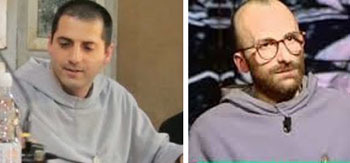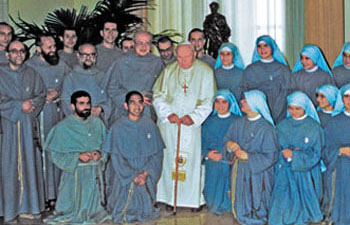The interreligious meeting on September 20, 2016, will be the fifth Assisi meeting attended by a pope. John Paul II presided at three of them: the first took place on October 27, 1986, on the occasion of the International Year of Peace promoted by the U.N.; the second in 1993, during the war in the Balkans; the third, planned in 2001 in the wake of the September 11 attacks in the United States, was held on January 24, 2002. PopeBenedict XVI convened a meeting of religions for peace, on the twenty-fifth anniversary of the first meeting, on October 27, 2011.
Pope Benedict XVI in Assisi on 27 October 2011.
For thirty years, following Leo XIII who condemned the Parliament of the World’s Religions (September 11-27, 1893), following Pius XI in his Encyclical Mortalium animos “on the unity of the true Church”, dated January 6, 1928 (see box), and the Instruction of the Holy Office “On the Ecumenical Movement” dated December 20, 1949 (see box), the Society of Saint Pius X has opposed this “spirit of Assisi” which destroys the missionary spirit of the Church that had been in force until Vatican Council II.
On August 27, 1986, two months before the first Assisi meeting, Abp. Marcel Lefebvre sent a letter to eight cardinals in which he declared: “He who now sits upon the Throne of Peter mocks publicly the first article of the Creed and the first Commandment of the Decalogue. The scandal given to Catholic souls cannot be measured. The Church is shaken to its very foundations. If faith in the Church, the only ark of salvation, disappears, then the Church herself disappears. All of her strength, all of her supernatural activity is based on this article of our faith.
“Is John Paul II to continue ruining the Catholic faith, in particular at Assisi, with the planned procession of religions in the streets of the town of St. Francis and assignment of religions to the various chapels of the basilica with a view to practicing their worship for the intention of peace as conceived by the United Nations?”
On January 21, 2002, Bp. Bernard Fellay, Superior General of the Society of Saint Pius X, issued a communiqué on the third interreligious union in Assisi which was to take place three days later. In it he set forth the precise reasons for the indignation of Catholics who are devoted to Tradition.
“The problem does not lie in the object of the prayers: peace. To pray for peace and to seek to establish and strengthen peace between peoples and nations is a good thing in itself. The Catholic liturgy is full of beautiful prayers for peace. We pray these prayers with all our hearts. Moreover, given the fact that the angels announced, on the birth of Our Lord Jesus Christ, peace on earth to men of good will, it is totally fitting to ask the faithful to implore the One True God to grant us a gift of such great value at this stage in the year.
“The reason for our indignation lies in the confusion, scandal and blasphemy that result from an invitation from the Vicar of Our Lord Jesus Christ, sole mediator between God and man, to other religions to come to Assisi to pray for peace.
“It has been stated that to avoid any syncretism, those attending will not be praying ‘together’, but that each religion will pray in separate rooms in the Franciscan convent at Assisi. Cardinal Kasper went so far—and rightly so—as to affirm that ‘Christians cannot pray with members of other religions.’ (L’Osservatore Romano, January 5, 2002). However, this affirmation is not enough to dissipate the dreadful uneasiness and confusion caused by the event; it cannot be denied that all kinds of religions will be praying ‘each in their own camp’ to obtain from these prayers said at the same time, but in different locations, the same result: peace. The fact that all have been invited to pray, at the same time and in the same town, for the same intention is clear proof of the desire for unity. On the other hand, the fact that the prayers will be offered in separate locations betrays the contradictory and impossible nature of the project. In reality, the distinction is false, even though, thanks be to God, it avoids a direct communicatio in sacris. However, the syncretic nature of the operation is obvious to all. Recourse to deceitful words has made it possible to deny the painfully obvious reality. But words do not mean anything any more: we will be going to Assisi, not to pray together, we are going there together to pray … no syncretism, etc.”
In the same statement the Superior General of the Society of Saint Pius X neatly distinguishes between legitimate diplomatic negotiations to obtain civil peace and the scandalous public interreligious prayers asking for peace from different divinities:
“The establishment of civil (political) peace between nations by congresses, discussions, diplomacy, with the intervention of influential persons of different nations and religions, is one thing. It is another to claim to obtain the gift of peace from God by the prayer of all (false) religions. Such an initiative is completely inconsistent with the Catholic faith and goes against the first commandment.…
“It is in keeping with the Masonic plot to establish a grand temple of universal brotherhood above all religions and beliefs, ‘Unity in diversity’, a concept so dear to the New Age and to globalization. “We were excommunicated by Clement XI in 1738 because of our interdenominational principles. But the Church was definitely in error, if it is true that, on 27 October 1986, the present Pope gathered together men of all religious confessions in Assisi to pray for peace. What else are our brothers looking for when they gather together in temples, than love between men, tolerance, solidarity, defense of the dignity of the human being, considering themselves equal, above political and religious beliefs and the color of their skin?’ (Grand Master Armando Corona, of the Grand Lodge of the Spring Equinox, Hiram, mouthpiece of the Grand Orient of Italy, April 1987)”
Two years later, in January 2004, the Society of Saint Pius X published a study entitled “From Ecumenism to Silent Apostasy” which it forwarded to all the cardinals. This title repeated the expression “silent apostasy” that John Paul II had used to describe the state of the Church in Europe in his Apostolic Exhortation Ecclesia in Europa (June 28, 2003): “Considered from the pastoral perspective, we are forced to conclude that the ecumenism of the last decades leads Catholics to a ‘silent apostasy’ and dissuades non-Catholics from entering into the one ark of salvation. One must therefore deplore ‘the impiety of those who close to men the gates of the Kingdom of heaven’. Under the guise of a search for unity, ecumenism disperses the flock; it does not carry the mark of Christ, but that of the divider par excellence, the devil (no. 43).
“As attractive as it may seem at first glance, as spectacular as its ceremonies may appear on television, and as numerous as the gathered crowds may be, the reality remains: ecumenism has made of the Holy City that is the Church a city in ruins. Pursuing a utopian ideal—the unity of the human race—this pope has not realized to what extent this ecumenism for which he has so labored is truly and sadly revolutionary: it inverts the order willed by God” (no. 44).
To conclude with a quotation from Abp. Lefebvre: “We wish to be in perfect unity with the Holy Father, but in the unity of the Catholic faith, because it is only this unity that can unite us, and not a sort of ecumenical union, a sort of liberal ecumenism; because I believe that the crisis in the Church is best defined by this liberal ecumenical spirit. I say liberal ecumenism, because there does exist a certain ecumenism that, if it is well defined, could be acceptable. But liberal ecumenism, such as it is practiced by the present Church and especially since the Second Vatican Council, includes veritable heresies” (no. 47, citing a conference given on April 14, 1978).
On January 9, 2011, when the fourth Assisi meeting was announced, which was to take place on October 22 of that year, with Benedict XVI presiding, Bp. Fellay gave a conference in Paris during which he declared: “Assisi has become a symbol. Saying that one is going to celebrate the 25th anniversary of this symbol, even if one attempts to clean it, to correct it, will not remove the meaning of the symbol. There is a message behind Assisi, and the only way to delete this message would be for the Vicar of Christ on earth to say, on this occasion, to all other religions: ‘There is only one Name under Heaven given to men by which we must be saved, and it is Our Lord Jesus Christ. Convert!’ If that is done, well then yes, we agree!”
(Sources: DICI/Archives – DICI no. 340 dated September 9, 2016)
http://www.dici.org/en/news/commentary-the-missionary-spirit-the-spirit-of-assisi/




















